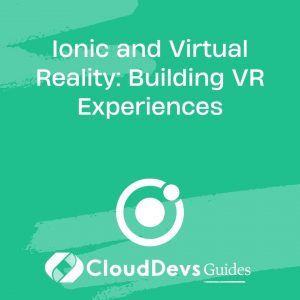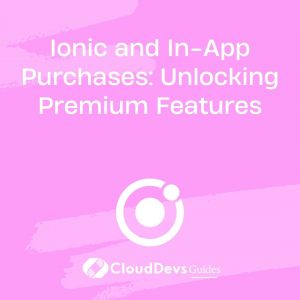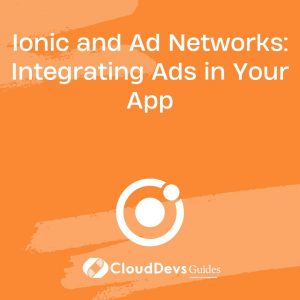Ionic and Virtual Reality: Building VR Experiences
Virtual Reality (VR) has come a long way from being a niche technology to a mainstream trend that is transforming various industries. From gaming and education to healthcare and architecture, VR is revolutionizing how we interact with digital content. If you’re an app developer looking to enter the exciting world of VR, you might be surprised to know that you can leverage the power of Ionic Framework to create immersive VR experiences.
Table of Contents
In this blog, we will explore how you can combine Ionic with VR technology to build captivating VR experiences. We will cover the basics of VR development, discuss the advantages of using Ionic, and provide you with code samples to get you started on your VR journey.
1. Understanding Virtual Reality
Before diving into the development aspect, let’s take a moment to understand what Virtual Reality is and how it works. VR is a computer-generated simulation of an immersive and interactive environment. Users typically wear a VR headset that tracks their head movements and displays a 3D environment that changes in response to their movements, creating a sense of presence and immersion.
1.1. Key components of VR include:
1.1.1. Head-Mounted Display (HMD)
The HMD is the VR headset that users wear to view the virtual environment. It often includes built-in screens and sensors to track head movements.
1.1.2. Motion Tracking
Motion tracking technology is essential for VR experiences. It allows the system to detect the user’s movements, including head rotations and hand gestures.
1.1.3. Stereoscopic 3D Display
VR relies on stereoscopic 3D displays to create depth perception, making objects in the virtual world appear three-dimensional.
1.1.4. Immersive Audio
Immersive audio is crucial for creating a realistic VR experience. Spatial audio techniques are used to simulate sound coming from different directions.
1.1.5. Interaction Devices
VR systems often include controllers or other input devices that allow users to interact with the virtual environment, such as grabbing objects or selecting options.
2. Why Use Ionic for VR Development?
Now that we have a basic understanding of VR, you might wonder why you should consider using Ionic for VR development. Ionic is a popular open-source framework for building cross-platform mobile and web applications. Here are some compelling reasons to choose Ionic for your VR projects:
2.1. Cross-Platform Compatibility
One of the standout features of Ionic is its ability to create apps that run seamlessly on multiple platforms, including iOS, Android, and the web. This cross-platform compatibility can save you a significant amount of development time and effort.
2.2. Familiar Development Environment
If you’re already familiar with web technologies like HTML, CSS, and JavaScript, you’ll feel right at home with Ionic. The framework leverages web technologies, making it accessible to a wide range of developers.
2.3. Extensive Plugin Ecosystem
Ionic offers a rich ecosystem of plugins and extensions that can be used to enhance your VR applications. Whether you need to integrate sensors, access device hardware, or add advanced features, there’s likely a plugin available to meet your needs.
2.4. Community and Support
Ionic boasts a large and active community of developers and a wealth of online resources. You can easily find tutorials, documentation, and community support to help you overcome any challenges you encounter during VR development.
2.5. Rapid Prototyping
Ionic’s rapid development capabilities make it an excellent choice for prototyping VR experiences. You can quickly iterate on your ideas and refine your VR application without extensive development cycles.
3. Setting Up Your Development Environment
Before you start building VR experiences with Ionic, you’ll need to set up your development environment. Here are the steps to get you started:
3.1. Install Node.js
Ionic relies on Node.js for its development environment. You can download and install Node.js from the official website (https://nodejs.org/). Ensure that npm (Node Package Manager) is also installed with Node.js.
3.2. Install Ionic CLI
Once Node.js is installed, open your terminal or command prompt and install the Ionic CLI globally using the following command:
shell npm install -g @ionic/cli
3.3. Create a New Ionic Project
Now that you have the Ionic CLI installed, you can create a new Ionic project. Navigate to your desired project directory and run the following command:
shell ionic start my-vr-app blank
This command will create a new Ionic project named “my-vr-app” based on the blank template.
3.4. Navigate to Your Project Directory
Change your current directory to the newly created project directory:
shell cd my-vr-app
3.5. Add Required Plugins
To start building VR experiences, you’ll need to add some plugins to your Ionic project. For VR development, you may want to explore plugins related to 3D rendering, motion tracking, and VR input devices. Use the following command to add a plugin:
shell ionic cordova plugin add PLUGIN_NAME
Replace PLUGIN_NAME with the name of the VR plugin you want to install.
With your development environment set up, you’re ready to start building VR experiences using Ionic. Let’s dive into some code samples to illustrate how to create a basic VR scene.
4. Building a Basic VR Scene with Ionic
In this section, we’ll walk through the process of creating a simple VR scene using Ionic. We’ll focus on rendering a 360-degree image, which is a common starting point for VR experiences. For this tutorial, we’ll assume you have some familiarity with Ionic and HTML/CSS.
4.1. Create an Ionic Page
First, create an Ionic page to house your VR scene. Run the following command:
shell ionic generate page vr-scene
This command will generate the necessary files and components for your VR scene.
4.2. Add VR Component
Inside the generated vr-scene directory, you’ll find an HTML file (e.g., vr-scene.page.html). Open this file and add the following code to create a basic VR scene:
html
<!-- vr-scene.page.html -->
<ion-header>
<ion-toolbar>
<ion-title>
VR Scene
</ion-title>
</ion-toolbar>
</ion-header>
<ion-content class="ion-padding">
<div id="vr-container">
<!-- Your VR content will go here -->
</div>
</ion-content>
This code sets up a basic Ionic page with a container for your VR content.
4.3. Add 360-Degree Image
Next, let’s add a 360-degree image to our VR scene. You can use a library like A-Frame (https://aframe.io/) to simplify VR development. Install A-Frame using npm:
shell npm install aframe
Now, modify your vr-scene.page.html to include the A-Frame components:
html
<!-- vr-scene.page.html -->
<ion-header>
<ion-toolbar>
<ion-title>
VR Scene
</ion-title>
</ion-toolbar>
</ion-header>
<ion-content class="ion-padding">
<div id="vr-container">
<a-scene embedded>
<a-sky src="path/to/your/360-image.jpg"></a-sky>
</a-scene>
</div>
</ion-content>
Replace “path/to/your/360-image.jpg” with the actual path to your 360-degree image.
4.4. Styling Your VR Scene
You can apply CSS styles to your VR scene to customize its appearance. Create a CSS file (e.g., vr-scene.page.scss) and add your styles:
css
/* vr-scene.page.scss */
#vr-container {
width: 100%;
height: 100vh;
}
a-scene {
height: 100%;
}
These styles ensure that your VR scene fills the entire viewport.
4.5. Test Your VR Scene
You can now test your VR scene by running your Ionic app:
shell ionic serve
Open your app in a web browser, and you should see your VR scene with the 360-degree image.
5. Enhancing Your VR Experience
Building a basic VR scene is just the beginning. To create a truly immersive VR experience, consider the following enhancements:
5.1. Interactivity
Add interactive elements to your VR scene, such as clickable hotspots, buttons, or 3D objects. You can use A-Frame’s components to handle user interactions.
5.2. Motion Tracking
Incorporate motion tracking to allow users to move their head to explore the VR environment. Many VR headsets provide built-in motion tracking capabilities.
5.3. 3D Models
Integrate 3D models into your VR experience to create a more realistic and dynamic environment. Libraries like three.js can help you work with 3D models.
5.4. VR Input
Support VR input devices like controllers to enable users to interact with the virtual world. This may involve adding event listeners for controller input.
5.5. VR Navigation
Implement a navigation system within your VR experience to guide users through different scenes or locations. This is particularly useful for VR tours or educational applications.
Conclusion
Virtual Reality is an exciting and rapidly evolving field that presents numerous opportunities for developers. By combining the power of Ionic Framework with VR technology, you can create immersive VR experiences that reach a broad audience across different platforms. Whether you’re building VR games, educational apps, or architectural visualizations, Ionic provides a flexible and familiar development environment to bring your VR ideas to life.
In this blog, we’ve covered the basics of VR development, explained why Ionic is a great choice for VR projects, and provided a step-by-step guide to building a basic VR scene. Remember that VR development is a multidisciplinary field that requires creativity, user experience design, and technical expertise. As you continue your VR journey, explore advanced features and best practices to create captivating and memorable VR experiences. Happy VR coding!
Table of Contents








